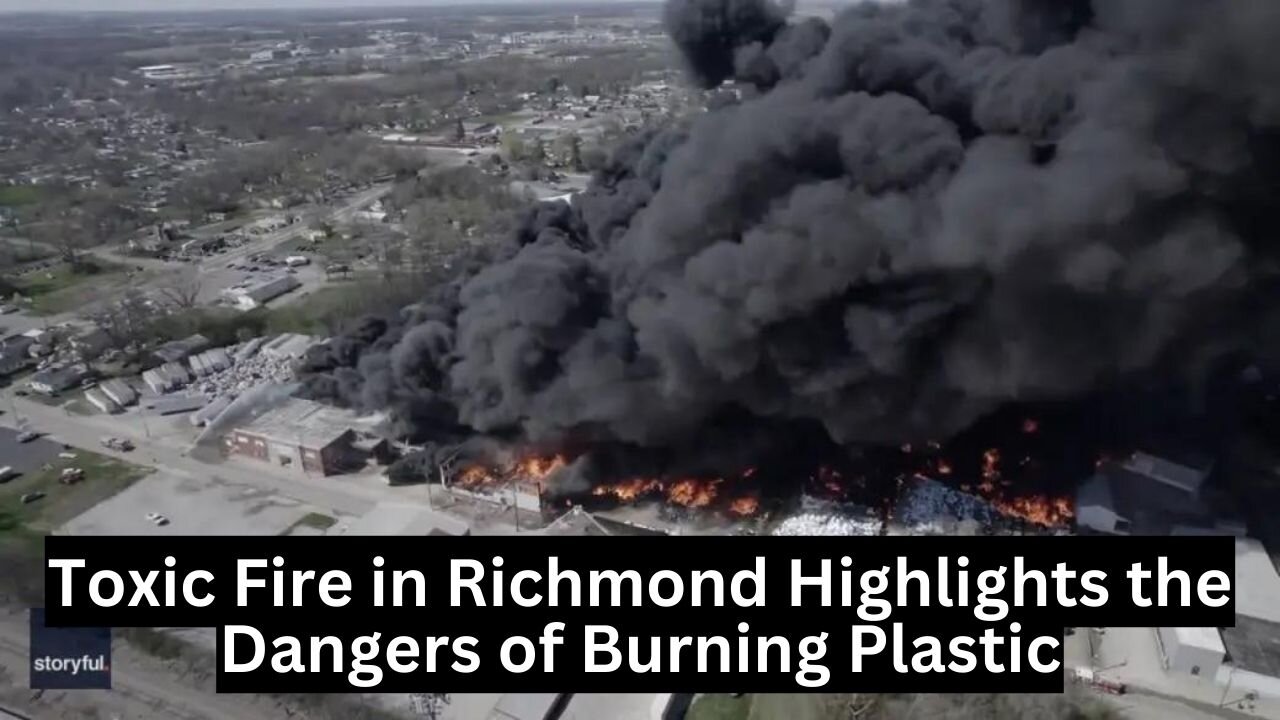Premium Only Content

Toxic Fire in Richmond Highlights the Dangers of Burning Plastic
A massive plume of black smoke billowed over Richmond, California, last week, as a fire at a plastics recycling plant released a toxic mix of chemicals into the air. The fire, which took several hours to bring under control, burned through stacks of plastic containers, releasing carcinogenic chemicals such as styrene, benzene, and polyaromatic hydrocarbons. According to Dr. Seth Peltier, a toxicologist at the University of California, Berkeley, “it’s important for people to avoid exposures” to these chemicals, as they can lead to a range of health problems.
In the short term, those exposed to the fumes may experience symptoms such as dizziness, nausea, coughing, headache, and fatigue. Those with asthma are at particular risk, as the exposure can trigger an attack. Long-term exposure to high concentrations of these chemicals can increase the risk of cancer.
For first responders dealing with the blaze, Dr. Peltier recommends wearing full-face respirators with tanked air, as they will be exposed to a mixture of particles and gases, some of which cannot be filtered. The fire in Richmond is a stark reminder of the dangers of burning plastic, and the need for precautions to protect the health of those involved in fighting such fires.
The incident in Richmond serves as a stark reminder of the dangers of plastic waste and the importance of proper disposal. The harmful chemicals released during plastic combustion can have serious health consequences for those who come into contact with them.
In addition to the health risks, incidents like this also highlight the impact of plastic waste on the environment. Plastic pollution is a major problem, with an estimated 8 million metric tons of plastic waste entering the oceans every year. This pollution has a devastating impact on marine ecosystems and can harm wildlife, including marine animals that mistake plastic for food.
To address this issue, it is crucial that individuals, businesses, and governments take action to reduce plastic waste and promote sustainable alternatives. This includes reducing plastic consumption, improving waste management practices, and investing in the development of sustainable materials.
The incident in Richmond should serve as a wake-up call for all of us to take action and work towards a cleaner, healthier, and more sustainable future. We owe it to ourselves and future generations to do our part in reducing plastic waste and protecting our planet.
I would suggest that it is important for individuals and businesses to properly dispose of plastic waste instead of resorting to burning it. The article highlights the harmful effects of burning plastic, including toxic smoke and air pollution that can lead to health problems for both humans and animals. It also emphasizes the importance of regulations and enforcement to prevent these types of incidents from occurring. Subscribe for more content like this.
In terms of personal action, individuals can make a difference by properly disposing of their plastic waste, recycling whenever possible, and supporting policies and initiatives that promote sustainable waste management. Additionally, businesses can prioritize reducing their plastic waste and implementing environmentally-friendly practices, such as using biodegradable packaging and supporting recycling programs.
The consequences of burning plastic can be severe and far-reaching. When plastic is burned, it releases harmful chemicals and pollutants into the air. These can include dioxins, furans, and other toxic compounds that are known to be carcinogenic and can cause respiratory problems, skin irritation, and other health issues.
In addition to the immediate health risks posed by burning plastic, there are also long-term environmental consequences. Plastic does not break down easily and can persist in the environment for hundreds of years. When it is burned, it releases greenhouse gases and contributes to climate change.
The toxic fire in Richmond mentioned in the article is a clear example of the dangers of burning plastic. The fire released large amounts of toxic smoke that posed a serious health risk to nearby residents. It also caused significant damage to the environment and required a massive cleanup effort.
Overall, the consequences of burning plastic are severe and far-reaching. It is important to find alternative methods for managing plastic waste that do not involve burning it. This can include recycling, composting, and reducing our overall use of plastic products.
There have been several instances of toxic fires caused by burning plastic waste in history. Here are some notable examples:
1. The Great Smog of London (1952): This environmental disaster was caused by a combination of cold weather, windless conditions, and high levels of air pollution, including the burning of coal and wood. The smog lasted for five days and caused an estimated 12,000 deaths.
2. Love Canal (1978): This neighborhood in Niagara Falls, New York, was built on top of a toxic waste dump that contained hazardous chemicals, including PCBs. The waste was not properly contained and eventually started to leak into nearby basements, yards, and even the local school. The resulting fires and health issues led to a national emergency and the eventual relocation of over 800 families.
3. Bhopal Disaster (1984): This industrial accident occurred in Bhopal, India, when a pesticide plant leaked methyl isocyanate gas into the surrounding area. The resulting toxic cloud caused thousands of deaths and long-term health effects for those exposed.
4. Grenfell Tower Fire (2017): This high-rise apartment building in London caught fire and burned for over 24 hours, causing 72 deaths and numerous injuries. The fire was caused by a faulty refrigerator, but it was exacerbated by the building's cladding, which was made of a plastic insulation material.
These examples illustrate the devastating consequences of toxic fires caused by burning plastic and other hazardous waste. They serve as reminders of the importance of proper waste management and the need for regulations and policies to prevent such disasters from happening again.
The consequences of major industrial disasters have varied widely depending on the specific circumstances and the response of those in charge. In some cases, the disaster has led to significant changes in safety regulations and practices, while in others, the response has been inadequate or even exacerbated the damage.
For example, in the case of the Bhopal disaster, the Indian government initially tried to downplay the severity of the incident and failed to provide timely medical aid to the victims. This led to a significant loss of life and long-term health problems for many survivors. The response of Union Carbide, the company responsible for the disaster, was also heavily criticized for being inadequate and insufficiently transparent.
On the other hand, the Chernobyl disaster led to significant changes in nuclear safety regulations and practices, as well as increased public scrutiny of the nuclear industry. In the wake of the disaster, the Soviet Union implemented new safety measures and improved emergency response procedures. While the long-term health effects of the disaster are still being studied, it is clear that the response to the disaster had a significant impact on the subsequent safety of nuclear power plants.
Overall, the response to major industrial disasters has varied widely depending on the specific circumstances, but it is clear that such disasters can have significant consequences for both the environment and public health, and it is important for those in charge to take appropriate action to mitigate these consequences and prevent similar incidents from happening in the future. Thanks for watching, subscribe our channel for authenticity.
-
 2:33:51
2:33:51
John Crump Live
17 hours ago $22.06 earnedSaturday Night Main Event!
98.5K12 -
 13:57
13:57
TimcastIRL
23 hours agoTrump NUKES IRS After DOGE Investigation, OVER 9000 Employees To Be FIRED
116K170 -
 13:35
13:35
Russell Brand
16 hours agoPFIZER JUST MADE THEIR NEXT MOVE AND EXPERTS ARE TERRIFIED
138K306 -
 1:15:57
1:15:57
Victor Davis Hanson Show
1 day agoOver Here, Over There: the Russo-Japanese War and Trumpian Peace Policy
65.6K35 -
 23:55
23:55
MYLUNCHBREAK CHANNEL PAGE
1 day agoThe Nephilim Are Here
92.8K88 -
 1:00:58
1:00:58
Break The Cycle w/ Joshua Smith
13 hours ago $1.72 earnedBreak The Cycle Ep. 247: Funny Guys w/ Robbie "The Fire" Bernstein
28.7K1 -
 41:26
41:26
TheTapeLibrary
1 day ago $9.94 earnedThe Disturbing Horrors of the Trans-Allegheny Lunatic Asylum
60.2K6 -
 10:07
10:07
Tundra Tactical
14 hours ago $6.72 earnedTRUMP'S HUGE GUN RIGHTS MOVE!
41.2K9 -
 1:53:23
1:53:23
Mally_Mouse
14 hours agoSaturday Shenanigans!! - Crowd Control - Content Warning
31K1 -
 17:24
17:24
Exploring With Nug
19 hours ago $3.67 earnedScuba Diving on Underwater Cars Searching For Missing Man!
41.7K1